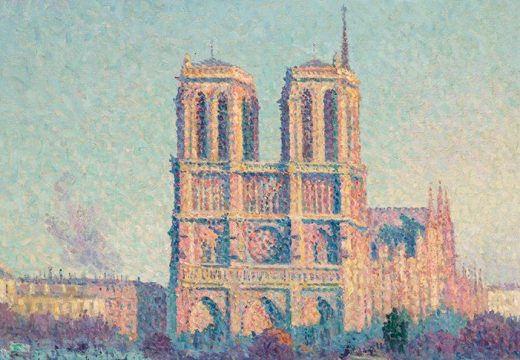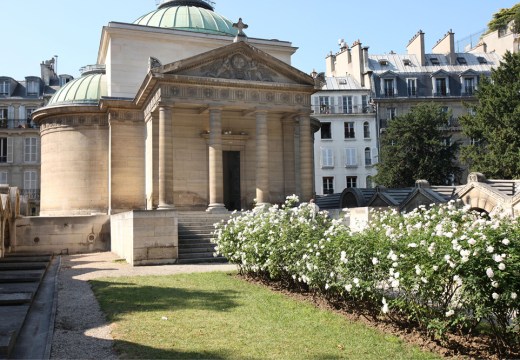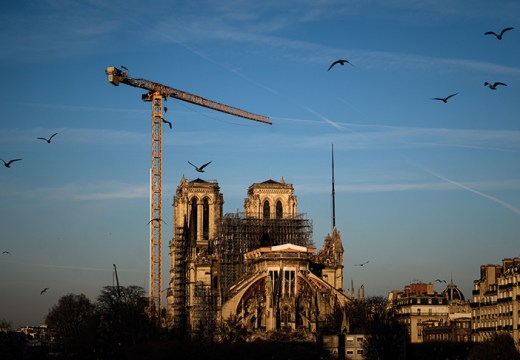From the December 2023 issue of Apollo. Preview and subscribe here.
This exhibition presents a meticulous assembly of liturgical and devotional objects from the cathedral of Notre-Dame de Paris. At its core is a host of 19th-century reliquaries bravely rescued by the pompiers from the devastating fire of 15 April 2019 and kept at the Louvre during restoration. After cleaning and conservation, Jannic Durand and his curatorial team have reunited these salvaged objects with disparate parts of the cathedral’s historic collection via an array of local and international loans. Their efforts are timely and the catalogue is a serious piece of scholarship. The extant inventories of Notre-Dame from 1343, 1416, and 1438 (edited and published in a monograph of 1951) offer a comprehensive account of its impressive constellation of shrines, such as the châsses for the Virgin Mary’s hair, three of John the Baptist’s teeth, and one of the stones that fatally struck Saint Stephen. Although nearly everything listed in the medieval inventories is long lost, the curators succeed in conveying this treasury’s scale and significance.

Reliquary of the Holy Crown of Thorns (1862), after Eugène Viollet-le-Duc
A sleek timeline in the atrium summarises major events in the cathedral’s history, beginning with the legendary apostolic mission of Saint Denis in the third century and ending with the recent fire. The show itself follows a tighter chronology, uniting more than 120 objects from the late Merovingian period to the Second Empire, culminating in the legacy of Eugène Viollet-le-Duc’s energetic restoration of 1845–65. Except for a handful of items that survived the destruction and dispersal of the treasury during the Revolution, when the cathedral was briefly transformed into a Temple of Reason, most of the collection dates from after 1804, when Notre-Dame served as the location for the (vain)glorious coronation of Napoleon. This narrows the focus of the exhibition and enables it to explore how the various items associated with the collection – from missals and graduals to processional crosses and portable reliquaries – function as symbolic props, using the cathedral as a stage. The result is neither a sentimental overview of loss and renewal at Notre-Dame, nor the grim mixture of brassy vessels and skeletal remains so often seen in Catholic treasuries. This is a sensitive display of artefacts and instruments that have witnessed and participated in the making of sacred history in Paris.
The earliest items in the collection will thrill medievalists. Glimpses into the Merovingian imagination are offered with a heavily used copy of Historia Francorum by Gregory of Tours (d. 594) and an assortment of items related to the cult of Saint Marcel, the sixth-century bishop-martyr dragon-slayer. An engraving from 1652 shows a crowded procession of his châsse snaking through the streets of Paris. Perhaps the most remarkable document on display is a c. 700 papyrus roll measuring 143cm, a copy of the so-called Testament of Ermintrude, which includes the first known donation to the treasury of Notre-Dame, a silver plate. Charters issued by Charlemagne in 775 and Louis the Pious in 814 confirm the site’s early dedication to the Virgin, and deluxe Gothic manuscripts line the rooms. Missals with greasy margins speak to their frequent use in mass, while others were evidently selected for rare views of the cathedral in their illuminations. A miniature in the Breviary of Louis de Guyenne, c. 1413–14, represents the procession of the True Cross reliquary delivered to the cathedral from the Holy Sepulchre by the canon Anseau around 1120. Although the original reliquary is lost, Anseau’s actual relic allegedly survives, embedded in a crystalline monstrance designed in 1901 by Maurice Poussielgue-Rusand – the only significant relic on show.
A clutch of books, prints, and pictures from the Ancien Régime, including Jacques-Germain Soufflot’s designs for his austere, multi-story treasury tower of c. 1775, evoke more sombre aesthetic values after the 16th-century Wars of Religion. But that all changes with the gigantic gilded liturgical furnishings from Napoleon’s imperial coronation in 1804. Jacques-Louis David’s monumental tableau Le Sacre de Napoléon (1807) hangs in a nearby room, but the wall opposite this vitrine presents a full-size replica with a detailed view of the high altar at Notre-Dame festooned with these same objects, making for an enjoyable game of ‘I spy.’ The yellow sheen of the towering processional cross and candlesticks smacks of dictator chic or neoclassical Trumpism; these inert but garish liturgical objects once formed part of a powerful propaganda machine. In the corner, David’s preparatory sketch, showing the emperor crowning himself, is another reminder of Napoleon’s brazen manipulation of ceremonial culture. Colonial aspects of the treasury are also evident in the display of jewelled chalices pilfered by Napoleon’s armies from Valladolid and Augsburg, arranged together as a cluster.

Reliquary of the nail and wood of the Cross, 1862, designed by Eugène Viollet-le–Duc and made by Placide Poussielgue-Rusand. Photo: © Musée du Louvre/Guillaume Benoit
The collection shifts from propaganda to nostalgia, and from neoclassical to neo-Gothic, with Viollet-le-Duc’s plans for a new treasury and new reliquaries with designs that harmoniously recall and reintegrate Notre-Dame’s medieval past. In 1802, after the concordat agreed to recognise the cathedral again, it received some of the Passion relics – including the entire Crown of Thorns – acquired in 1239 by Saint Louis and formerly stored in the Sainte-Chapelle, which had been deconsecrated in 1793 and converted into an archive. The exhibition closes with a phalanx of these shimmering but empty 19th-century reliquaries – magnificent machines without their batteries – including a crystalline case for the Holy Nail lifted by angels and a jewelled but transparent Crown of Thorns, modelled on the original Gothic monstrance and surrounded by seated figures of Saint Helen, Emperor Baldwin II and Saint Louis. This is an extremely rewarding study of the construction of sacred power. In 2024, the items from the treasury will return to the cathedral to mark its reopening, shaping the experience of veneration of another generation of visitors.
‘Le trésor de Notre-Dame de Paris: des origines à Viollet-le-Duc’ is at the Musée du Louvre, Paris, until 29 January 2024.
From the December 2023 issue of Apollo. Preview and subscribe here.
Unlimited access from just $16 every 3 months
Subscribe to get unlimited and exclusive access to the top art stories, interviews and exhibition reviews.














![Masterpiece [Re]discovery 2022. Photo: Ben Fisher Photography, courtesy of Masterpiece London](http://www.apollo-magazine.com/wp-content/uploads/2022/07/MPL2022_4263.jpg)
Has arts punditry become a perk for politicos?